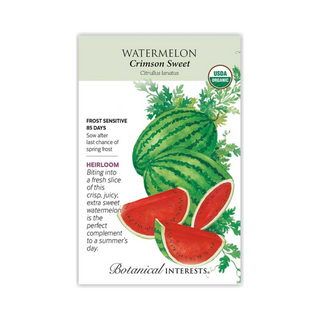
Description
Watermelon—the word brings to mind the long, lazy days of summer, picnics, and barbecues. 'Crimson Sweet' is a high-quality old standard of home gardens, weighing about 20–25 pounds with bright crimson flesh. With just a little care, it can be easily grown in northern climates; see inside of packet for details. Bottom turns ivory when ripe. Resistant to Fusarium wilt and anthracnose.
Variety Info
- Days to Maturity: 85 days
- Family: Cucurbitaceae
- Type: Watermelon
- Native: Africa
- Hardiness: Frost-sensitive annual
- Exposure: Full sun
- Plant Dimensions: 6'–10' vines
- Variety Info: Crimson Sweet' produces 12"x10", 20–25 pound fruit with brilliant red, crisp, very sweet flesh. The rind is medium green with dark green striping. Resistant to Fusarium wilt and anthracnose.
- Attributes: Fusarium Wilt Resistant, Anthracnose Resistant, Frost Sensitive
Sowing Info
- When to Sow Outside: RECOMMENDED. 1 to 2 weeks after your average last frost date, and when soil temperature is 70°–90°F.
- When to Start Inside: Not recommended except in very short growing seasons, 2 to 4 weeks before transplanting. Roots are sensitive to disturbance; sow in biodegradable pots that can be planted directly into the ground. Transplant when soil temperature is at least 60°F.
- Days to Emerge: 5–10 days
- Seed Depth: ½"
- Seed Spacing: 2–3 seeds per mound
- Row Spacing: 4'–6' apart
- Thinning: When 3 leaves, thin to 1 plant per mound
Growing Info
- Harvesting: It can be tricky to know exactly when a watermelon is ripe and ready to pick. First, know the number of "days to harvest" and begin checking fruits as harvest date draws closer. Signs to look for are: (1) the bottom of the melon (where it lies on the soil) turns from light green to a yellowish color; (2) the surface color of the fruit turns dull; (3) the skin becomes resistant to penetration by the thumbnail and is rough to the touch; and (4) light green, curly tendril on the stem near the point of attachment of the melon is brown and dry. All of these indicators may not necessarily occur at the same time.
Description
Watermelon—the word brings to mind the long, lazy days of summer, picnics, and barbecues. 'Crimson Sweet' is a high-quality old standard of home gardens, weighing about 20–25 pounds with bright crimson flesh. With just a little care, it can be easily grown in northern climates; see inside of packet for details. Bottom turns ivory when ripe. Resistant to Fusarium wilt and anthracnose.
Variety Info
- Days to Maturity: 85 days
- Family: Cucurbitaceae
- Type: Watermelon
- Native: Africa
- Hardiness: Frost-sensitive annual
- Exposure: Full sun
- Plant Dimensions: 6'–10' vines
- Variety Info: Crimson Sweet' produces 12"x10", 20–25 pound fruit with brilliant red, crisp, very sweet flesh. The rind is medium green with dark green striping. Resistant to Fusarium wilt and anthracnose.
- Attributes: Fusarium Wilt Resistant, Anthracnose Resistant, Frost Sensitive
Sowing Info
- When to Sow Outside: RECOMMENDED. 1 to 2 weeks after your average last frost date, and when soil temperature is 70°–90°F.
- When to Start Inside: Not recommended except in very short growing seasons, 2 to 4 weeks before transplanting. Roots are sensitive to disturbance; sow in biodegradable pots that can be planted directly into the ground. Transplant when soil temperature is at least 60°F.
- Days to Emerge: 5–10 days
- Seed Depth: ½"
- Seed Spacing: 2–3 seeds per mound
- Row Spacing: 4'–6' apart
- Thinning: When 3 leaves, thin to 1 plant per mound
Growing Info
- Harvesting: It can be tricky to know exactly when a watermelon is ripe and ready to pick. First, know the number of "days to harvest" and begin checking fruits as harvest date draws closer. Signs to look for are: (1) the bottom of the melon (where it lies on the soil) turns from light green to a yellowish color; (2) the surface color of the fruit turns dull; (3) the skin becomes resistant to penetration by the thumbnail and is rough to the touch; and (4) light green, curly tendril on the stem near the point of attachment of the melon is brown and dry. All of these indicators may not necessarily occur at the same time.

